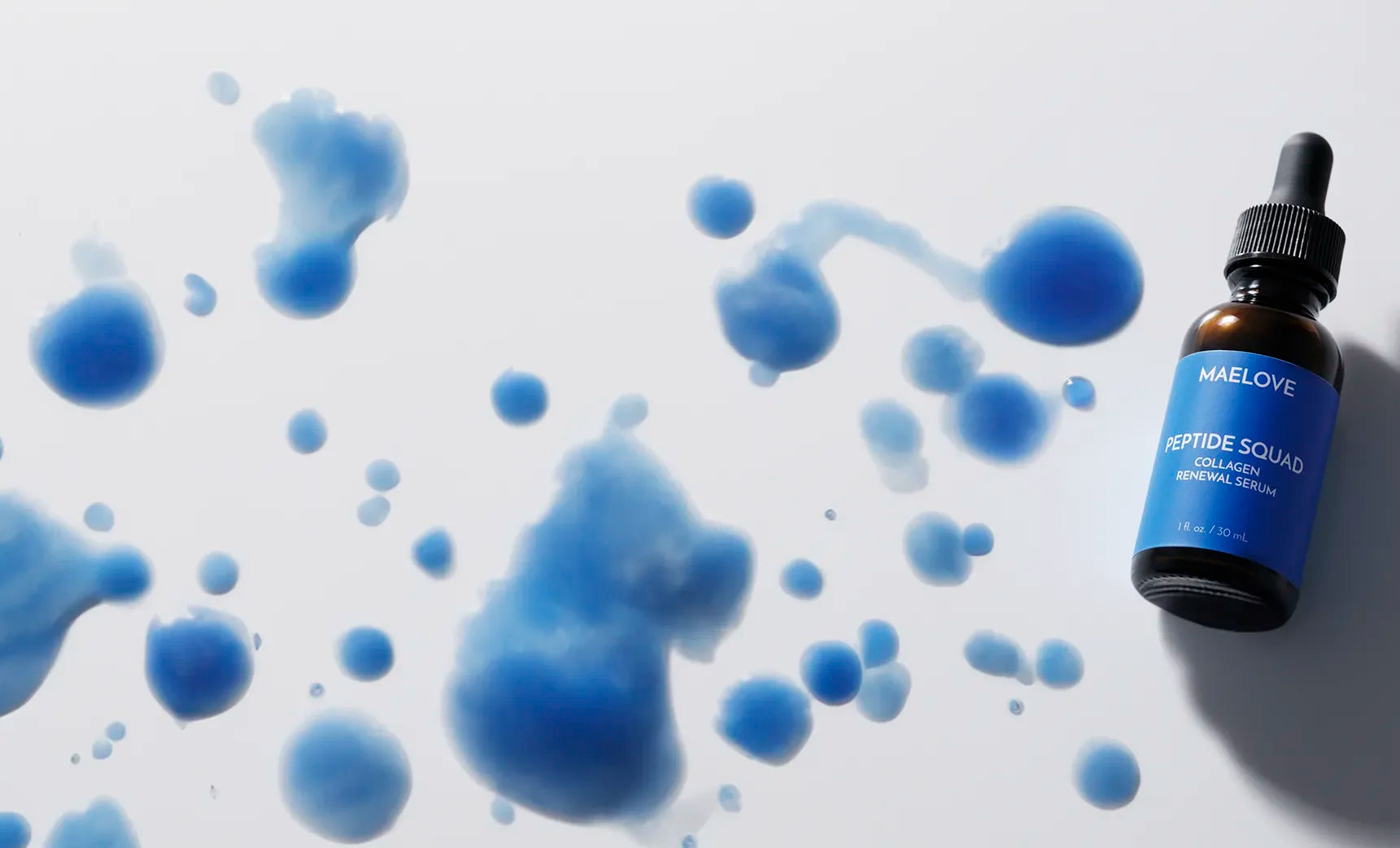Ferreira MS, Magalhaes MC, Sousa-Lobo JM, Almeida IF (2020). “Trending Anti-Aging Peptides.” Cosmetics 7: 91. Doi:10.3390/cosmetics7040091
Gorouhi F and Maibach HI (2009). “Role of topical peptides in preventing or treating aged skin.” Int J Cosmetic Sci. 31: 327-345.
Schagen SK (2017). “Topical Peptide Treatments with Effective Anti-Aging Results.” Cosmetics 4:16. Doi:10.3390/cosmetics4020016.
Errante F, Ledwon P, Latajka R, Rovero P, Papini AM (2020). “Cosmeceutical Peptides in the Framework of Sustainable Wellness Economy.” Frontiers in Chemistry 8: 572923. Doi: 10.3389/fchem.2020.572923.
Gorouhi F and Maibach HI (2009). “Role of topical peptides in preventing or treating aged skin.” Int J Cosmetic Sci. 31: 327-345.
Lintner K (2002). “Promoting production in the extracellular matrix without compromising barrier.” Cutis 70(6Suppl): 13–16.
Maquart FX, Siméon A, Pasco S, Monboisse JC (1999). “Regulation of cell activity by the extracellular matrix: the concept of matrikines.” J Soc Biol 193: 423–428.
Pickart L, Thaler MM (1973). “Tripeptide in human serum which prolongs survival of normal liver cells and stimulates growth in neoplastic liver.” Nat New Biol 243: 85–87.
Pickart L, Vasquez-Soltero JM, Margolina A (2015). “GHK Peptide as a Natural Modulator of Multiple Cellular Pathways in Skin Regeneration.” BioMed Research International 648108. http://dx.doi.org/10.1155/2015/648108.
Pickart L, Margolina A (2018). “Regenerative and Protective Actions of the GHK-Cu Peptide in the Light of the New Gene Data.” Int J Mol Sci 19. Doi:10.3390/ijms19071987.
Sederma, Matrixyl 3000 fact sheet. https://eyzhnelen.gr/wp-content/uploads/2018/05/ProductInformationFile_MATRIXYL-3000.pdf
US patent 2004/0132667 A1. Lintner K (2005). “Compositions containing mixtures of tetrapeptides and tripeptides.” https://patentscope.wipo.int/search/en/detail.jsf?docId=WO2005048968
US Patent 2012/164488. Fournial A, Mondon P (2012). “New Cosmetic or Dermopharmaceutical Topical Use of a Mixture of a Ghk Tripeptide and Gqpr Tetrapeptide.” https://patents.google.com/patent/WO2012164488A2/en
Blanes-Mira C, Clemente J, Jodas G, Gil A, Fernandez-Ballester G, Ponsati B, Gutierrez L, Perez-Paya E, Ferrer-Montiel A (2002). “A synthetic hexapeptide (Argireline) with antiwrinkle activity.” Int J Cosmet Sci 24(5): 303-310.
Draelos ZD, Kononov T, Fox T (2016). “An Open Label Clinical Trial of a Peptide Treatment Serum and Supporting Regimen Designed to Improve the Appearance of Aging Facial Skin.” J Drugs Dermatol 15(9): 1100-1106.
Errante F, Ledwon P, Latajka R, Rovero P, Papini AM (2020). “Cosmeceutical Peptides in the Framework of Sustainable Wellness Economy.” Frontiers in Chemistry 8: 572923. Doi: 10.3389/fchem.2020.572923.
Lipotec Argireline. https://www.lubrizol.com/Personal-Care/Products/Product-Finder/Products-Data/Argireline-Amplified-peptide-solution
Lungu C, Considine E, Zahir S, Ponsati B, Arrastia S, Hallett M (2013). “Pilot Study of Topical Acetyl Hexapeptide-8 in Treatment of Blepharospasm in Patients Receiving Botulinum Neurotoxin Therapy.” Eur J Neurol. 20(3): 515-518.
Tadini KA, Mercurio DG, Campo PMBGM (2015). “Acetyl hexapeptide-3 in a cosmetic formulation acts on skin mechanical properties – clinical study.” Brazilian J Pharmaceutic Sci 51(4): 901-909. Doi.org/10.1590/S1984-82502015000400016.
Abdulghani AA, Sherr A, Shirin S, Solodkina G, Tapia EM, Wolf B, Gottlieb AB Abdulghani J, Sherr V (1998). “Effects of topical creams containing vitamin C, a copper-binding peptide cream and melatonin compared with tretinoin on the ultrastructure of normal skin – A pilot clinical, histologic, and ultrastructural study.” Dis Manag Clin Out 1(4): 136-141
Badenhorst T, Svirskis D, Merrilees M, Bolke L, Wu Z (2016). “Effects of GHK-Cu on MMP and TIMP Expression, Collagen and Elastin Production, and Facial Wrinkle Parameters.” J Aging Sci 4: 166. Doi:10.4172/2329-8847.1000166.
Errante F, Ledwon P, Latajka R, Rovero P, Papini AM (2020). “Cosmeceutical Peptides in the Framework of Sustainable Wellness Economy.” Frontiers in Chemistry 8: 572923. Doi: 10.3389/fchem.2020.572923.
Gorouhi F and Maibach HI (2009). “Role of topical peptides in preventing or treating aged skin.” Int J Cosmetic Sci. 31: 327-345.
Leyden JJ, Grove G, Stephens TJ, Finkey MB, Barkovic S, Appa Y (2002). “Skin benefits of copper peptide containing facial cream.” American Academy of Dermatology 60th Annual Meeting, February 22-27, New Orleans, LA.
Pickart L, Vasquez-Soltero JM, Margolina A (2015). “GHK-Cu may prevent oxidative stress in skin by regulating copper and modifying expression of numerous antioxidant genes.” Cosmetics 2: 236-246. Doi:10.3390/cosmetics2030236.
Escobar S, Valois A, Nielsen M, Closs B, Kerob D (2021). “Effectiveness of a formulation containing peptides and vitamin C in treating signs of facial ageing: three clinical studies.” Int J Cosmetic Sci 43: 131-135.
Ferreira MS, Magalhaes MC, Sousa-Lobo JM, Almeida IF (2020). “Trending Anti-Aging Peptides.” Cosmetics 7: 91. Doi:10.3390/cosmetics7040091
Purnamawati S, Indrastuti N, Danarti R, Saefudin T (2017). “The Role of Moisturizers in Addressing Various Kinds of Dermatitis: A Review.” Clinical Medicine and Research 15(3-4): 75-87.
Schagen SK (2017). “Topical Peptide Treatments with Effective Anti-Aging Results.” Cosmetics 4:16. Doi:10.3390/cosmetics4020016.
Shin JW, Kwon SH, Choi JY, Na JI, Huh CH, Choi HR, Park KC (2019). “Molecular Mechanisms of Dermal Aging and Antiaging Approaches.” Int J Mol Sci 20: 2126. Doi: 10.3390/ijms20092126.
Chiou SH (1983). “DNA- and protein-scisson activities of ascorbate in the presence of copper ion and a copper-peptide complex.” J Biochem 94(4): 1259-1267.
Chiou SH, Chang WC, Jou YS, Chung HM, Lo TB (1985). “Specific Cleavages of DNA by Ascorbate in the Presence of Copper Ion or Copper Chelates.” J Biochem 98(6): 1723-1726.
Errante F, Ledwon P, Latajka R, Rovero P, Papini AM (2020). “Cosmeceutical Peptides in the Framework of Sustainable Wellness Economy.” Frontiers in Chemistry 8: 572923. Doi: 10.3389/fchem.2020.572923.
Li H, Toh PZ, Tan JY, Zin MT Lee CY, Li B, Leolukman M, Bao H, Kang L (2016). “Selected Biomarkers Revealed Potential Skin Toxicity Caused by Certain Copper Compounds.” Scientific Reports 6: 37664. Doi:10.1038/srep37664.















